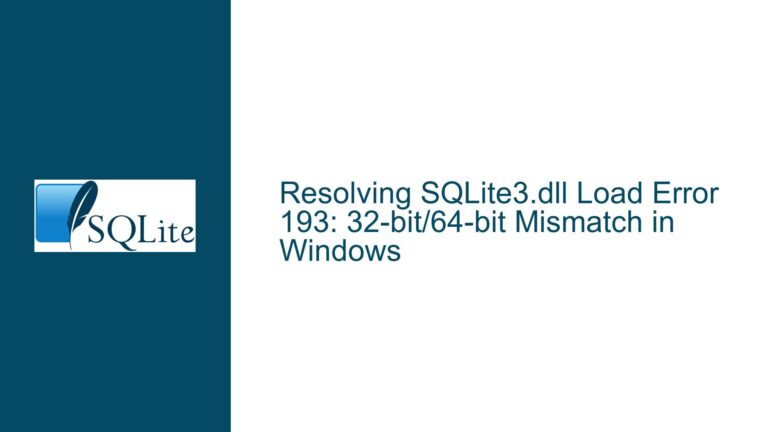Custom xConnect Error Message Overwritten by ‘No Such Table’ in SQLite
Understanding the Suppression of Custom Virtual Table Errors in xConnect
When implementing a table-valued function using SQLite’s virtual table API, developers may encounter a scenario where a custom error message generated in the xConnect method is unexpectedly replaced by a generic "no such table" error. This issue arises specifically when the virtual table constructor (sqlite3_declare_vtab) fails due to SQL syntax errors or other initialization problems. Despite correctly propagating the error through the xConnect function’s pzErr parameter, the SQLite engine’s internal error-handling logic overwrites the custom message with a default one.
The problem occurs because SQLite’s table lookup mechanism (sqlite3LocateTable) prioritizes its own error reporting over custom errors generated during virtual table initialization. When the virtual table creation fails, the engine assumes the table does not exist and forcibly sets the error message to "no such table" or "no such view," discarding any context-specific error information provided by the xConnect implementation. This behavior can obscure critical debugging information, making it harder to diagnose issues like SQL syntax errors in virtual table definitions.
The root of the issue lies in the interaction between the virtual table initialization workflow and SQLite’s error propagation logic. Even though the xConnect method correctly populates the pzErr parameter and returns an error code, higher-level functions responsible for locating or initializing tables do not check whether an error message has already been set. Instead, they unconditionally override the error state, resulting in the loss of developer-provided diagnostics.
Key Factors Leading to Error Message Overwrite
1. Order of Operations in Virtual Table Initialization
SQLite’s virtual table initialization involves multiple stages:
- Module Registration: The virtual table module is registered via
sqlite3_create_module_v2. - Table Resolution: During query preparation, SQLite attempts to locate the table using
sqlite3LocateTable. - Constructor Invocation: If the table is an eponymous virtual table (one that is automatically created when referenced), SQLite invokes the
xConnectmethod.
The error overwrite occurs because sqlite3LocateTable assumes that a missing table is the sole reason for failure. It does not account for the possibility that the xConnect method might have already set an error message. This oversight leads to a race condition where the last error message set (by sqlite3LocateTable) takes precedence.
2. Error Handling in sqlite3VtabEponymousTableInit
The sqlite3VtabEponymousTableInit function bridges the gap between the virtual table constructor (xConnect) and the table resolution logic. When xConnect fails, this function correctly captures the error message from pzErr and propagates it to the database connection’s error buffer. However, the subsequent call to sqlite3LocateTable ignores this propagated error and replaces it with its own.
3. Lack of Error State Awareness in sqlite3LocateTable
The sqlite3LocateTable function is designed to report missing tables but does not check whether an error has already been logged by lower-level functions like xConnect. The following code snippet from SQLite’s source highlights the problem:
if( p==0 ){
const char *zMsg = flags & LOCATE_VIEW ? "no such view" : "no such table";
if( zDbase ){
sqlite3ErrorMsg(pParse, "%s: %s.%s", zMsg, zDbase, zName);
}else{
sqlite3ErrorMsg(pParse, "%s: %s", zMsg, zName);
}
}
Here, sqlite3ErrorMsg is called unconditionally if the table pointer p is NULL, overwriting any prior error message.
Resolving the Error Message Overwrite: Workarounds and Fixes
1. Upgrade to a Patched SQLite Version
The SQLite development team addressed this issue in commit bbbbeb59a6a14b94. This patch modifies sqlite3LocateTable to preserve existing error messages. Developers should:
- Check SQLite Version: Verify that the SQLite library in use includes the fix (versions after 3.36.0).
- Recompile or Update: Integrate the patched SQLite source code or use a precompiled binary that includes the fix.
2. Modify Virtual Table Error Handling
If upgrading is not feasible, adjust the xConnect implementation to work around the issue:
- Capture Errors Earlier: Validate the virtual table’s SQL schema before invoking
sqlite3_declare_vtab. For example:static int testVTabConnect(...) { // ... const char *zSchema = "CREATE TABLE x(Value INTEGER PRIMARY KEY) BAD SYNTAX HERE;"; rc = sqlite3_declare_vtab(connection, zSchema); if (rc != SQLITE_OK) { // Manually log the error to stderr or a log file fprintf(stderr, "Virtual table error: %s\n", sqlite3_errmsg(connection)); // Set pzErr (though it may still be overwritten) *pzErr = sqlite3_mprintf("%s", sqlite3_errmsg(connection)); return rc; } // ... } - Use Side Channels for Diagnostics: Log errors to external files or application-specific buffers to retain diagnostics even if SQLite’s error message is overwritten.
3. Leverage SQLite’s Error Stack
SQLite’s sqlite3_error_offset and sqlite3_errstr APIs can provide additional context for debugging:
- Retrieve Extended Error Codes: Use
sqlite3_extended_errcodeto capture more detailed error information. - Combine Error Sources: Cross-reference the generic error message with logs from the
xConnectmethod to identify the root cause.
4. Custom Patch for Older SQLite Versions
For mission-critical systems requiring older SQLite versions, backport the fix from commit bbbeb59a6a14b94:
- Modify
sqlite3LocateTable: Add a check for an existing error before setting "no such table":if( p==0 ){ if (pParse->rc == SQLITE_OK) { // Only set error if none exists const char *zMsg = flags & LOCATE_VIEW ? "no such view" : "no such table"; if( zDbase ){ sqlite3ErrorMsg(pParse, "%s: %s.%s", zMsg, zDbase, zName); }else{ sqlite3ErrorMsg(pParse, "%s: %s", zMsg, zName); } } } - Recompile SQLite: Apply the patch and rebuild the library.
5. Validation in Application Code
Prevent xConnect errors by validating virtual table schemas at compile time:
- Use SQLite’s PRAGMA Function: Execute the schema as a standalone query to catch syntax errors before declaring the virtual table:
rc = sqlite3_exec(connection, "CREATE TEMP TABLE __temp_vtab_check AS " zSchema, 0, 0, &zErr); if (rc != SQLITE_OK) { // Handle schema error } - Unit Testing: Implement automated tests that exercise virtual table creation and verify error messages.
By understanding the interplay between virtual table initialization and SQLite’s error-handling pipeline, developers can mitigate this issue through targeted upgrades, code adjustments, or diagnostic enhancements. The key is ensuring that custom error messages are either preserved by the engine or captured through alternative means before they are overwritten.






